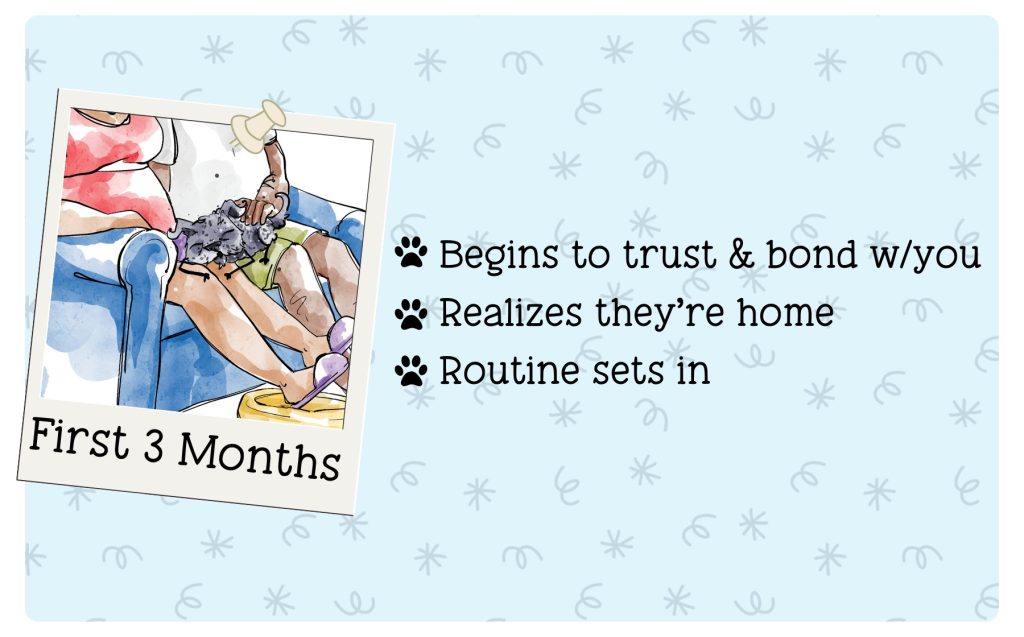Adopting a rescue dog can be an exciting experience, but it can also be challenging. Rescue dogs, especially those who have been in the shelter for a long time or are older, need time to adjust and acclimate. Depending on their background, they might also have some unexpected behavior quirks.
Shelters and rescues have created a framework to help navigate this transition that, if you learn and understand, can be the key to helping your dog thrive. This framework is called the 3/3/3 rule. While it’s important for adults to understand this rule, it’s equally important for kids to understand it as well.
What is the 3/3/3 rule?
The 3/3/3 rule is two-fold:
- It’s a set of well-documented behaviors that are often off putting that dogs exhibit during a typical adjustment phase when living with a new family. They often occur during the first three days, three weeks, and three months a dog is in its new home
- It’s also a set of recommended solutions that help a dog adjust to its new home, mitigating the risk of behavior issues that might cause a family to consider re-homing their new pet.
Let’s dive into the three stages a bit more.
The first three days

For many dogs, the first three days are a time of major overwhelm. If they’ve been in a shelter for a while they’re likely sleep deprived and have been in a state of constant stress. This stress often manifests in the following ways during the first three days:
- Sleeping– they may sleep WAY more than you might expect
- Hiding or Withdrawal– dogs will often gravitate towards a quiet, dark place. They may be resistant to touch, avoiding eye contact and showing little interest in their new home
- Not eating– Being nervous, your dog may not eat and will drink little water
During the first three days, here’s how you can help your dog:
- Create a safe space– designate a quiet, comfortable area for a new dog that is their own. Include their bed, some toys, fresh water, anything that helps them understand that space is for them. This can be a great time to get them used to a crate. My dog fell in love with a small corner under the bed, and that’s where she spends most of her day now!
- Establish routine– As much as possible, try to be home more often during this time so you can create a consistent routine for feeding, walks, and playtime. A predictable schedule helps reduce anxiety.
- Patience and calm- Approach your dog calmly and gently. Avoid overwhelming them with too much interaction or unfamiliar stimuli. If you have other pets, don’t force interaction right away!
After a few days, your dog will move into the ‘settling in’ phase.
The first three weeks:

Once your dog has started to learn the rhythm of your home and your routine, their personality will begin to emerge.
- Personality quirks– During this time, you’ll start to see your dog’s real personality. Now that they are comfortable with you, daily habits will be more evident.
- Increased socialization- your new dog will feel more comfortable exploring their surroundings and engaging with family members. They will exhibit a more relaxed demeanor and willingness to interact.
- Bad Habits– If there are any bad habits they picked up in their previous life or at the rescue/shelter, this is when they’ll start to appear. Remember: your dog feels safe around you, so be patient. These behaviors mean they’re starting to see you as family!
How you can help your dog:
- Positive reinforcement- Treats and encouragement are your friends during this phase. Rewarding positive behavior builds your dog’s confidence and strengthens your bond.
- Gradual socialization- As your dog gets more comfortable, begin introducing your dog to new people, pets, and environments gradually. Make sure to control interactions, monitor their reactions, and proceed at a pace that’s comfortable for them.
- Training and enrichment- Begin basic training with your dog. This not only helps them understand house rules, but can also stimulate their mind. If you haven’t trained a dog before, find a professional trainer. Most offer small group classes, and there are some who will even visit your home!
A great way to provide mental stimulation and bring joy to your dog is puzzle toys and interactive games. Personally, I love giving my dog choices. I’ll hold out two treats and let her choose the one she wants or let her lead on our walk, giving her time and space to sniff her surroundings.
The first three months:

By this time, your dog has adapted to their new home and their behavior becomes more consistent. Here’s what you can expect:
- Settled behavior- If you’ve spent time getting to know your dog, their likes, dislikes, and habits will become more apparent.
- Bonding- You’ll see a stronger bond develop between you and your dog. They may exhibit more affection and may even follow you around more often.
Here’s how you can help your dog:
- Ongoing training: even after a dog masters a particular command, you want to keep testing them consistently. To make it more challenging, start ‘chaining’ commands, challenging them to do multiple commands for the same level of treats. Continue to reinforce good behavior and keep working on issues. Depending on your dog’s personality, different types of training, such as sniff work and agility training could be great activities for you to do together.
- Keep a predictable routine- Where possible, maintain a stable routine for exercise, rest, and play. Dogs are literally creatures of habit, so knowing what to expect makes them feel more secure
- Regular vet visits- Make sure to have a vet you know and trust for check-ups and to ensure your dog’s maintaining a good level of health.
Why it’s important to teach the 3/3/3 Rule to Kids

Now that you have a deeper understanding about the 3/3/3 rule, here are some benefits to making sure your kids understand it as well:
Fosters patience and empathy
Teaching your kids the 3/3/3 rule helps them understand the adjustment period a dog needs. Without this understanding, they might expect immediate bonding or interaction with a new dog. This can lead to frustration on the part of your child or, worse, create a situation where a dog lashes out.
Encourages respect for the dog’s space
Helping children understand a dog’s need for quiet and space, especially in the first three days, is helpful for a number of reasons. First, it avoids mishaps if a child unintentionally invades a dog’s safe space or tries to interact before it’s ready. By teaching kids to respect their dog’s need for space, you’re also teaching them the importance of personal boundaries and respect.
Building Positive Interactions
Understanding that a dog’s comfort levels and socialization will develop gradually helps children engage with the dog in a positive and non-threatening way. Encourage kids to be gentle and patient, reinforcing positive behavior through treats and praise. This helps the dog become more comfortable and establishes a foundation in which their relationship can thrive.
Some final thoughts
Teaching children about the 3/3/3 rule not only helps them understand and support their new pet but also fosters a sense of empathy, responsibility, and respect. By incorporating these lessons into their daily interactions with the dog, children can contribute to a smoother transition and a stronger, more positive relationship with their new furry family member.
If you’re interested in teaching your kids about the 3/3/3 rule, check out The Odd Dog’s Guide to Making Friends, a children’s book I created to teach kids about this very subject!


